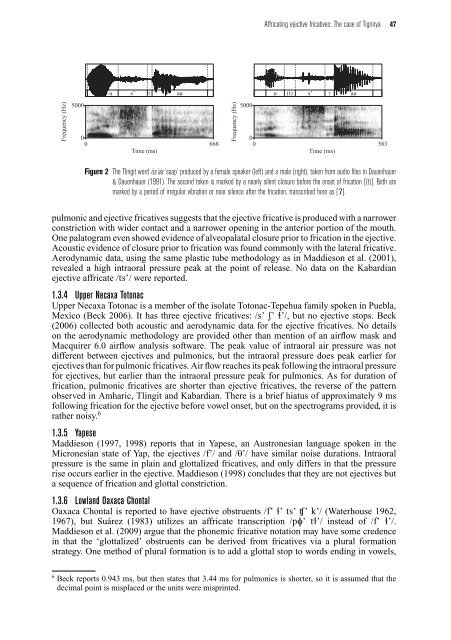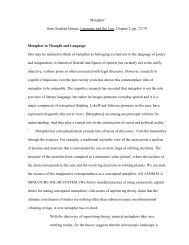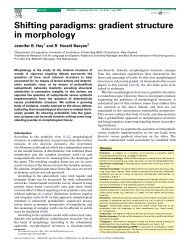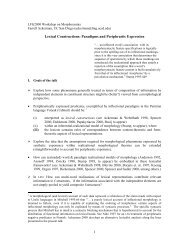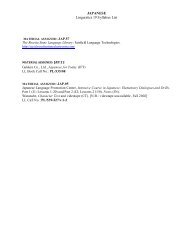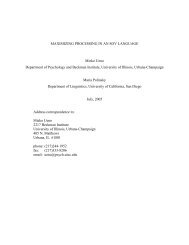46 Ryan K. Shosted & Sharon Roseright after the peak, whereas the plain fricative shows a slower increase and decrease. Peakintraoral pressure is twice as high for <strong>ejective</strong>s as it is for pulmonics, but subglottal pressureis not significantly different.Electropalatography (EPG) and static palatography reveal that the Amharic <strong>ejective</strong>fricative has wider contact in the alveopalatal region, which Demolin (2002: 472) interprets asa reduction in the overall size <strong>of</strong> the oral cavity, probably intended to reduce the supralaryngealcavity size and thereby maximize pressure. <strong>The</strong>re is an alveopalatal closure observed for bothsingleton and geminate <strong>ejective</strong> <strong>fricatives</strong>. Demolin (2002: 473) concludes that oral and glottalclosures are simultaneous, but oral constriction is released before glottal closure.1.3.2 TlingitTlingit, a Na-Dene language spoken in the Pacific Northwest coast <strong>of</strong> North America has six<strong>ejective</strong> <strong>fricatives</strong>, /s’ ¬’ x’ x ’ X’ X ’/, five <strong>ejective</strong> stops, /t’ k’ k ’ q’ q ’/, and three <strong>ejective</strong>affricates, /ts’ ’ t¬’/ (Maddieson et al. 2001). All <strong>of</strong> these sounds have plain pulmoniccounterparts. Maddieson et al. (2001) present both acoustic and aerodynamic data for the<strong>ejective</strong> <strong>fricatives</strong>. Word-initial <strong>ejective</strong> <strong>fricatives</strong> are characterized by an approximately 46 mssilent interval following a word-initial fricative, punctuated by a release (<strong>of</strong> glottal closure)into the vowel. Word-final <strong>fricatives</strong> are flanked by silent intervals, and there is a detectablerelease burst approximately 39 ms after the silent period. <strong>The</strong> noisy portion <strong>of</strong> the fricativeis significantly shorter in an <strong>ejective</strong> fricative than a pulmonic fricative (word-initial 148 msvs. 222 ms and word-final 127 ms vs. 301 ms, respectively), and the noise is ‘scrapy’ (brokeninto a series <strong>of</strong> pulses). Maddieson et al. (2001: 159) postulate that this scrapy quality (whichthey did not observe in /s’/) occurs due to intermittent closures <strong>of</strong> the oral channel, possiblyrelated to the presence <strong>of</strong> saliva in a very narrow constriction. <strong>The</strong> scrapy quality may alsobe caused by friction at the aryepiglottic folds (Esling 1996, Moisik 2008). Maddieson et al.(2001: 172) explicitly reject the possibility that the scrapy quality is a glottal phenomenon.Given the high intraoral pressure observed during <strong>ejective</strong> <strong>fricatives</strong>, they argue that glottalpulsing would require an ‘improbably high’ level <strong>of</strong> subglottal pressure. Although pulmonic<strong>fricatives</strong> undergo final lengthening in Tlingit, <strong>ejective</strong> <strong>fricatives</strong> do not.Intraoral air pressure data was recorded by speakers holding a narrow plastic tubepositioned between the lips with the open end resting against the center <strong>of</strong> the hard palate.Pressure behind the constriction was detected through the tube and recorded using Macquirerhardware and s<strong>of</strong>tware. A series <strong>of</strong> calibration recordings were then made using a U-tubemanometer. <strong>The</strong> intraoral pressure trace for Tlingit <strong>ejective</strong> <strong>fricatives</strong> is parabolic, with ahigh peak level between 14 hPa and 17 hPa, but without a sustained peak, compared withbetween 5.2 hPa and 8.6 hPa for pulmonic <strong>fricatives</strong>. Air pressure is presumably maintainedby forcing air through a narrower supraglottal constriction, which could also explain thescrapy, pulsing quality <strong>of</strong> the fricative noise. Maddieson et al. (2001) propose that the silentperiods flanking frication are due to glottal closure overlapping the entire fricative. <strong>The</strong> silentinterval before frication appears to occur variably, as illustrated by a word with a word-medial<strong>ejective</strong> fricative uttered by two different native speakers (Dauenhauer & Dauenhauer 1991;see Figure 2). It is not clear why the closure preceding frication is interpreted as glottal ratherthan oral. No data on the <strong>ejective</strong> affricates were reported to test how contrast is realizedbetween the fricative/affricate pairs [s’] and [ts’] or [¬’] and [t¬’].1.3.3 KabardianKabardian (Gordon & Applebaum 2006) is a Northwest Caucasian language which has three<strong>ejective</strong> <strong>fricatives</strong>: /f’ S’ ¬’/ as well as an <strong>ejective</strong> affricate /ts’/ and a series <strong>of</strong> <strong>ejective</strong>sstops: /p’ t’ k ’ k ’ q’/. Gordon & Applebaum (2006) found that the <strong>ejective</strong> <strong>fricatives</strong>had shorter frication duration (average 130 ms) than their pulmonic counterparts (191 ms)in word-initial position. Frication was <strong>of</strong>ten characterized by pulsing noise, as in Tlingit.Ejective <strong>fricatives</strong> were characterized by a long VOT lag, or silent period before vowel onset,and were less intense than the pulmonics. Comparison <strong>of</strong> palatograms for the alveopalatal
<strong>Affricating</strong> <strong>ejective</strong> <strong>fricatives</strong>: <strong>The</strong> <strong>case</strong> <strong>of</strong> <strong>Tigrinya</strong> 47Figure 2 <strong>The</strong> Tlingit word ús’aa ‘soap’ produced by a female speaker (left) and a male (right), taken from audio files in Dauenhauer& Dauenhauer (1991). <strong>The</strong> second token is marked by a nearly silent closure before the onset <strong>of</strong> frication [(t)]. Both aremarked by a period <strong>of</strong> irregular vibration or near silence after the frication, transcribed here as [/].pulmonic and <strong>ejective</strong> <strong>fricatives</strong> suggests that the <strong>ejective</strong> fricative is produced with a narrowerconstriction with wider contact and a narrower opening in the anterior portion <strong>of</strong> the mouth.One palatogram even showed evidence <strong>of</strong> alveopalatal closure prior to frication in the <strong>ejective</strong>.Acoustic evidence <strong>of</strong> closure prior to frication was found commonly with the lateral fricative.Aerodynamic data, using the same plastic tube methodology as in Maddieson et al. (2001),revealed a high intraoral pressure peak at the point <strong>of</strong> release. No data on the Kabardian<strong>ejective</strong> affricate /ts’/ were reported.1.3.4 Upper Necaxa TotonacUpper Necaxa Totonac is a member <strong>of</strong> the isolate Totonac-Tepehua family spoken in Puebla,Mexico (Beck 2006). It has three <strong>ejective</strong> <strong>fricatives</strong>: /s’ S’ ¬’/, but no <strong>ejective</strong> stops. Beck(2006) collected both acoustic and aerodynamic data for the <strong>ejective</strong> <strong>fricatives</strong>. No detailson the aerodynamic methodology are provided other than mention <strong>of</strong> an airflow mask andMacquirer 6.0 airflow analysis s<strong>of</strong>tware. <strong>The</strong> peak value <strong>of</strong> intraoral air pressure was notdifferent between <strong>ejective</strong>s and pulmonics, but the intraoral pressure does peak earlier for<strong>ejective</strong>s than for pulmonic <strong>fricatives</strong>. Air flow reaches its peak following the intraoral pressurefor <strong>ejective</strong>s, but earlier than the intraoral pressure peak for pulmonics. As for duration <strong>of</strong>frication, pulmonic <strong>fricatives</strong> are shorter than <strong>ejective</strong> <strong>fricatives</strong>, the reverse <strong>of</strong> the patternobserved in Amharic, Tlingit and Kabardian. <strong>The</strong>re is a brief hiatus <strong>of</strong> approximately 9 msfollowing frication for the <strong>ejective</strong> before vowel onset, but on the spectrograms provided, it israther noisy. 61.3.5 YapeseMaddieson (1997, 1998) reports that in Yapese, an Austronesian language spoken in theMicronesian state <strong>of</strong> Yap, the <strong>ejective</strong>s /f’/ and /T’/ have similar noise durations. Intraoralpressure is the same in plain and glottalized <strong>fricatives</strong>, and only differs in that the pressurerise occurs earlier in the <strong>ejective</strong>. Maddieson (1998) concludes that they are not <strong>ejective</strong>s buta sequence <strong>of</strong> frication and glottal constriction.1.3.6 Lowland Oaxaca ChontalOaxaca Chontal is reported to have <strong>ejective</strong> obstruents /f’ ¬’ ts’ ’ k’/ (Waterhouse 1962,1967), but Su arez ⁄ (1983) utilizes an affricate transcription /p∏’ t¬’/ instead <strong>of</strong> /f’ ¬’/.Maddieson et al. (2009) argue that the phonemic fricative notation may have some credencein that the ‘glottalized’ obstruents can be derived from <strong>fricatives</strong> via a plural formationstrategy. One method <strong>of</strong> plural formation is to add a glottal stop to words ending in vowels,6 Beck reports 0.943 ms, but then states that 3.44 ms for pulmonics is shorter, so it is assumed that thedecimal point is misplaced or the units were misprinted.


